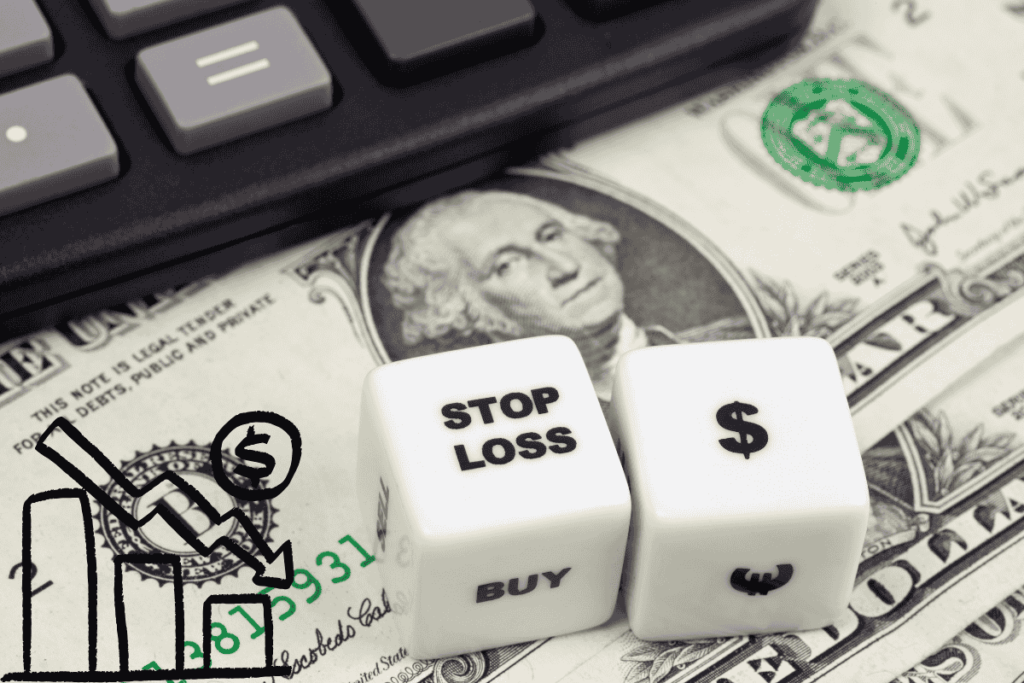Did you know over 90% of traders will lose money during their first trading year? This statistic is shocking, but some ways can protect your investment and limit your losses. Enter the stop-loss order. You’ve heard about it but may not be using it properly.
This blog will explain all you need to know about stop-loss orders.

What is a Stop Loss Order (SLO)?
Stop loss orders are preset instructions you give your broker so that they automatically buy or sell an asset at a certain price. This is a great way to avoid large losses and get out of a trading situation before it gets too bad. Stop loss limits how much you can lose on a trade.
Imagine you are willing only to lose $10 if you purchase a $100 stock. Set your stop-loss at $90. If the price drops below $90, your broker will sell it for you. This will limit your loss to $10.
Why is it important to have a Stop Loss Order?
Stop-loss orders are essential, especially in today’s volatile markets. You may lose more money than you expected if you do not have a plan. Stop-loss orders can be important for several reasons.
- Stop loss is a risk management tool. The amount you lose will be limited to what you are willing to accept.
- Peace of mind: Stop loss works automatically, so you do not need to monitor your market constantly.
- Avoid Emotional Trading. It is easy to become panicked and make rash decisions when prices drop. Stop loss eliminates emotion from the trading process.
- Capital Protection: Protecting your trading capital is key to remaining in the market for long enough to earn profits. A stop loss ensures you can continue trading even after a loss.
How does a stop-loss order work?
Creating a stop-loss order is easy, but knowing how it works will make a huge difference in how you use it. Here’s a quick breakdown:
- Purchase the Asset: First, you purchase an asset such as a cryptocurrency, stock or other trading assets.
- Set the Stop-Loss Price: Decide what you are willing to risk. Set your stop-loss price below (or above if you’re selling) the market price.
- Market movement: If your asset’s price drops to your stop-loss level, your trade closes automatically, and your broker will sell it at this price.
Example:
Say you purchased a $50 stock. You set the stop loss to $45, which means you are only willing to lose $5 in this trade. Stop loss is triggered if the price drops below $45. Your stock will then be sold at this price.
Types of stop loss orders
Understanding the different types of stop-loss orders will help you select the best one for your strategy. Understanding stop-loss orders and their different types will help you choose the right one for your strategy.
Fixed Stop Loss Order
Stop loss is the most common and basic stop loss. The order is activated when the market reaches the price you set. If you buy a stock for $100 and place a stop-loss at $90, your trade will close if it drops below $90.
Trailing Stop Loss Order
A trailing stop is more dynamic. It adjusts as the market price changes in your favor. Set your trailing stops at $10 below current market prices. The stop will “trail” as the price increases. Your stop loss will increase to $100 if the price moves from $100 to $101. If the price falls, however, the stop-loss remains in place. This locks in profits and limits losses.
Stop Limit Order
Stop limit orders add a condition to stop loss. You can set both a limit and a stop price. You could, for example, set a price limit of $89 and a price stop of $90.00. When the stop price is reached, it’s a limit order. An order is only executed at or above the limit price. This is useful in volatile markets but may not execute if a price drops too quickly.
How you can use stop-loss orders effectively
You should use stop-loss orders to protect trades without prematurely reducing profits. Make the most of it.
Calculate your risk tolerance
Do not risk more than you can afford. Most traders do not risk more than 1-2% of capital on any single trade. Your account will not be wiped out if the trade does not go well.
Use Technical Analysis
Many traders use support and resistance levels to determine where to place their stop loss. Support levels are the areas where prices tend to stop falling, bounce back and stop rising. Resistance levels are the areas where they tend to stop rising and stop falling. Avoiding being stopped prematurely by placing your stop loss below the support levels is an effective way to avoid losing money.
Stay flexible with a trailing stop loss.
If you want to lock in profits when the market moves your way, a trailing stop loss can be a good option. The stop loss will “trail” the price as it rises. It allows you to protect your downside while locking in profits.
Set the stop loss too close.
If you place your stop loss near the current price, normal market fluctuations may stop you. Beginner traders often make this mistake. Set your stop loss further away to avoid this.
A Real-Life Stop Loss Order Example
Look at a real-life example to understand the workings of stop-loss orders.
- Imagine that you are trading Apple stocks (AAPL). Based on an analysis, you decide to purchase 10 shares of the stock at $150. Do you want to protect yourself if stock prices drop?
- Set your stop loss to $140, and your broker will sell your shares only if it falls below that level. This limits your loss to just $10 per share.
- Let’s say Apple’s share price drops and reaches $140. Your broker sells 10 shares of Apple stock at $140 after your stop-loss order has been triggered. You didn’t lose more money because you only lost $100 (10 shares at $10 each). You could have lost much more money if you had not set a stop loss.
When Should You Use Stop Loss Orders?
In the following situations, you should consider using stop-loss orders:
Stop Loss Protection for Trading on Volatile Markets. Stop-loss orders can be used to protect against sudden price drops.
Stop Loss When You Cannot Monitor Your Trades. If you cannot monitor the markets, stopping losses will protect your trades even if you are not paying attention.
Stop Loss for High-Risk Trading: Setting a stop-loss can limit the amount you lose in high-risk trading.
Common mistakes:
Avoid these common mistakes when using stop-loss orders. A powerful tool for managing risk, stop loss orders. However, they may have unintended consequences if they are not used correctly. Common mistakes traders make:
1. Set it too Close
As we have already mentioned, putting your stop loss close to the current market price may cause you to be stopped out of the trade too early, even if it eventually goes in your favor.
2. Ignoring market volatility
Prices can move wildly both ways in highly volatile markets. You may want to adjust the stop loss to consider larger price fluctuations if you are trading on such markets.
3. Not using a stop loss at all
Some traders believe they can “handle” market fluctuations and do not use stop losses. This can be risky and lead to large losses if caught off guard by a sudden market move.
Conclusion:
Every Trader Should Use Stop Loss Orders
Stop-loss orders are important for traders who wish to be experts in trading risk management. Setting a stop-loss can protect your investments and reduce emotional trading. It will also give you peace of mind. Learn how to properly use stop-loss orders to keep your trading strategies on track and to handle market fluctuations better.
Stop-loss orders are not only about preventing losses but also about controlling them. Next time you trade, set your stop-loss order to protect your capital.
The Key Takeaways
- Stop loss orders are instructions that automatically sell or purchase an asset at a preset price to limit losses.
- These tools are essential for managing risk and can be used to avoid making emotional decisions.
- Stop loss orders and trailing or stopping limits can be fixed.
- Avoid placing a stop-loss too close to the current price.
Understanding and applying stop-loss strategies will help you reduce risk, improve your trading, and become a more seasoned trader.




